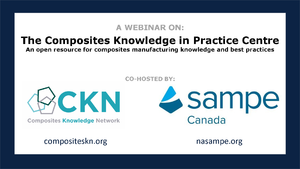The Composites Knowledge in Practice Centre – an open resource for composites manufacturing knowledge and best practices - A256
Introduction[edit | edit source]
Composites are incredible materials when things go right – they enable innovative and otherwise impossible products. But manufacturing is difficult, and help is often needed to develop, optimize and troubleshoot processes. Sometimes the help needed is direct guidance on specific best practices to deal with an immediate issue, and sometimes there is time to expand knowledge in a broader sense. Join us in a guided tour and demonstration of the Knowledge in Practice Centre (KPC), where composites manufacturing practice is presented in an easy-to-navigate manner, tied to a structured science and engineering base. See how you can easily navigate from case studies to practical advice to systems-level and foundational knowledge. Built off the same platform as Wikipedia, the KPC uses a factory representation of material, shape, tooling, and equipment to explain how composites processes work and how manufacturing quality, rate, and cost trade off in practice.
Webinar attendees will gain access to this first release of the KPC, which is intended to be a resource open to the composites community. We welcome both knowledge users as well as knowledge providers – we will share our vision of how the KPC can help demystify and democratize composites manufacturing practice and knowledge.
Webinar[edit | edit source]
Webinar slides[edit | edit source]
Webinar slides available by clicking on the icon below
Additional information for select chapters[edit | edit source]
| Chapter | Chapter Title | Links to related information in the Knowledge in Practice Centre | |
|---|---|---|---|
| 1 | Welcome & introductions | N/A | |
| 2 | Why we have the Knowledge in Practice Centre (KPC) | N/A | |
| 3 | The KPC's approach (the MSTEP concept) | ||
| 4 | Example of the MSTEP concept in a generic factory | ||
| 5 | Managing quality (themes, tradeoffs and workflows) | ||
| 6 | Different uses of the KPC | ||
| 7 | KPC Architecture | ||
| 8 | KPC Demo: Preliminaries | ||
| 9 | KPC Demo: Table of Contents and home page | ||
| 10 | KPC Demo: Introduction to Composites volume | ||
| 11 | KPC Demo: Foundational Knowledge volume | ||
| 12 | KPC Demo: Systems Knowledge volume | ||
| 13 | KPC Demo: Practice volume | ||
| 14 | KPC Demo: Case Study volume | ||
| 15 | KPC Demo: Perspectives volume | ||
| 16 | KPC Demo: Search functionality | ||
| 17 | Summary and invitation to contribute | N/A | |
| 18 | Q&A | N/A |
| About | Help |
Welcome
Welcome to the CKN Knowledge in Practice Centre (KPC). The KPC is a resource for learning and applying scientific knowledge to the practice of composites manufacturing. As you navigate around the KPC, refer back to the information on this right-hand pane as a resource for understanding the intricacies of composites processing and why the KPC is laid out in the way that it is. The following video explains the KPC approach:
Understanding Composites Processing
The Knowledge in Practice Centre (KPC) is centered around a structured method of thinking about composite material manufacturing. From the top down, the heirarchy consists of:
- The factory
- Factory cells and/or the factory layout
- Process steps (embodied in the factory process flow) consisting of:
The way that the material, shape, tooling & consumables and equipment (abbreviated as MSTE) interact with each other during a process step is critical to the outcome of the manufacturing step, and ultimately critical to the quality of the finished part. The interactions between MSTE during a process step can be numerous and complex, but the Knowledge in Practice Centre aims to make you aware of these interactions, understand how one parameter affects another, and understand how to analyze the problem using a systems based approach. Using this approach, the factory can then be developed with a complete understanding and control of all interactions.
Interrelationship of Function, Shape, Material & Process
Design for manufacturing is critical to ensuring the producibility of a part. Trouble arises when it is considered too late or not at all in the design process. Conversely, process design (controlling the interactions between shape, material, tooling & consumables and equipment to achieve a desired outcome) must always consider the shape and material of the part. Ashby has developed and popularized the approach linking design (function) to the choice of material and shape, which influence the process selected and vice versa, as shown below:
Within the Knowledge in Practice Centre the same methodology is applied but the process is more fully defined by also explicitly calling out the equipment and tooling & consumables. Note that in common usage, a process which consists of many steps can be arbitrarily defined by just one step, e.g. "spray-up". Though convenient, this can be misleading.
Workflows
The KPC's Practice and Case Study volumes consist of three types of workflows:
- Development - Analyzing the interactions between MSTE in the process steps to make decisions on processing parameters and understanding how the process steps and factory cells fit within the factory.
- Troubleshooting - Guiding you to possible causes of processing issues affecting either cost, rate or quality and directing you to the most appropriate development workflow to improve the process
- Optimization - An expansion on the development workflows where a larger number of options are considered to achieve the best mixture of cost, rate & quality for your application.
To use this website, you must agree to our Terms and Conditions and Privacy Policy.
By clicking "I Accept" below, you confirm that you have read, understood, and accepted our Terms and Conditions and Privacy Policy.






